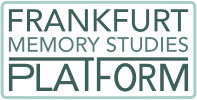Two PhD Project Presentations:
Frankfurt, 19 June 2018 12-2 pm (ST) // IG 1.414 (Campus Westend)

Carolin Gebauer
Narrating (in) the Here-and-Now: Narrative Dynamics in the Present-Tense Novel
The most common understanding of narrative is based on the assumption that the events constituting a story precede the narrative act, i.e. that telling a story is merely possible in retrospect. As a consequence, the prototypical (literary) narrative generally displays what, in classical narratology, has become known as “subsequent” or “ulterior” narration. This applies equally to conversational storytelling, the most ‘natural’ form of narration we usually encounter in everyday life. Even though many languages seem to allow for seamless transitions between past tense and present tense when we share our experiences with others through interpersonal verbal recounting, we always follow the logical rule that “we cannot tell [life] while we live it” (Cohn) and vice versa.
The contemporary present-tense novel seems to break with this convention, as it creates a narrative scenario that is logically impossible: the consistent use of the present tense suggests that the narrative events are presented while they are happening. By insinuating a synchronicity between story and narration, present-tense narrative defies the mimetic paradigm which is based on the premise of retrospection and instead leads readers to believe that they are dealing with an instance of what narratologists traditionally refer to as “simultaneous” or “concurrent” narration.
This paper investigates the narrative dynamics of present-tense narration. Proceeding from the observation that the lack of temporal distance between story and narrative discourse complicates the spatiotemporal configurations of the present-tense novel, I will argue that the genre facilitates a specific type of “narrative progression” (Phelan) which is not to be found in past-tense narratives. To do so, I will draw on Mikhail M. Bakhtin’s concept of the chronotope, proposing a distinction between two types of time-spaces we may encounter in present-tense narrative: the time chronotope and the space chronotope. While the former concentrates on representing complex sequences of events which unfold in an abstract space, the latter focuses not so much on a coherent representation of events as on a detailed depiction of the narrative’s setting as well as the characters’ emotional responses to their environment.

Sofie Friederike Mevissen
Flight and Expulsion in Postmemorial Metafiction. Ulrike Draesner’s Novel Sieben Sprünge vom Rand der Welt (2014)
In contemporary German prose the social structure of the family serves as a key medium to track the national history and to unfold the collective past, predominantly on the basis of individual life-stories from the perpetrators’ perspective. Therein different generations illustrate a certain generational struggle, in which issues often revolve around an unknown familiy secret related to the past of a family member.
Center stage is the third generation of descendants, who have no lived or experienced memories, but who are affected by forms of Postmemory, as the term Marianne Hirsch implemented for this phenomenon of affiliation. According to Hirsch members of the Generation of Postmemory are entangled with “history by deep personal connection”, which is related to a certain desire to trace the origins of their identity in the genealogic structure of the family.
The transmission of a hidden or secret experience of the past is fictionalised in recent transgenerational German family novels. In so doing therein the collective of the family signifies an ambivalent tension between forms of displacing and negotiating the past experiences. Ulrike Draesner’s novel Sieben Sprünge vom Rand der Welt (2014) focusses ways of transmitting the history of flight and expulsion of the German population of Silesia in 1945 in WWII by letting the characters reflect on the discourse of postmemorial affiliation themselves as an aesthetic representation of historical metafiction. In the depiction of multiple perspectives of the German as well as the Polish descendants the novel serves as an example for the way how literature functions as a tool for reflecting issues of the historiography of WWII in the 21st century.


